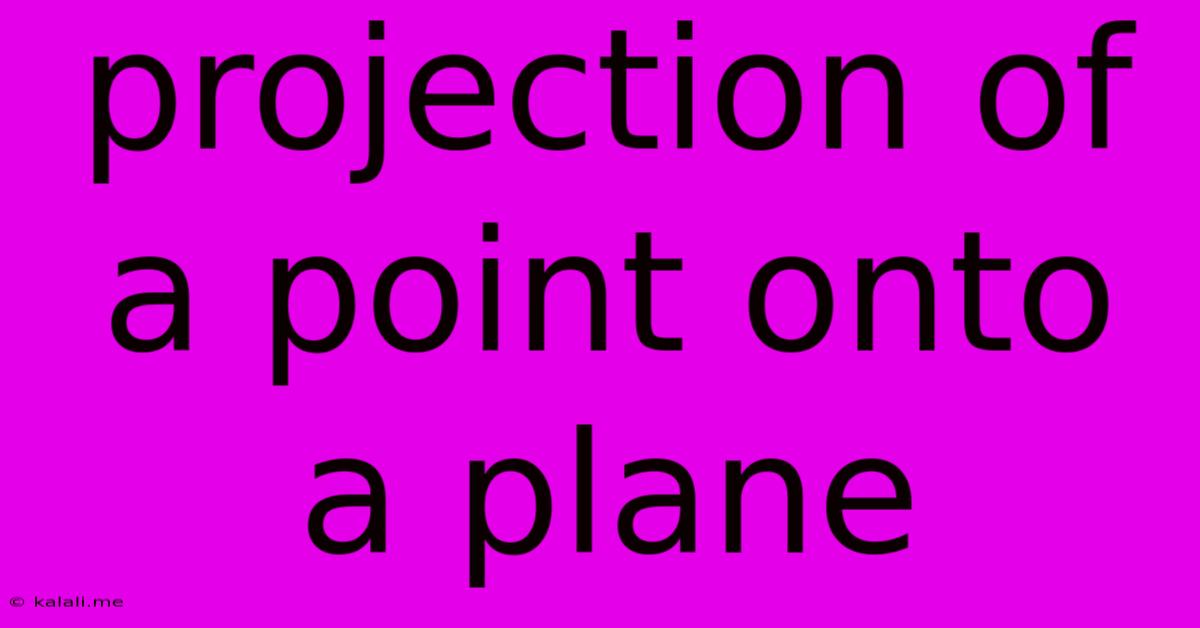Projection Of A Point Onto A Plane
Kalali
Jun 10, 2025 · 3 min read

Table of Contents
Projecting a Point onto a Plane: A Comprehensive Guide
Meta Description: Learn how to project a point onto a plane using vector projection. This guide covers the underlying mathematics, provides step-by-step examples, and explores various applications in 3D graphics and computer vision.
Projecting a point onto a plane is a fundamental concept in linear algebra with wide-ranging applications in various fields, including computer graphics, computer vision, and robotics. This process involves finding the closest point on a plane to a given point in space. Understanding this concept is crucial for tasks such as determining the shortest distance between a point and a plane, or for transforming 3D coordinates to 2D representations. This article provides a comprehensive explanation of the process, accompanied by clear examples.
Understanding the Geometry
Imagine a point P in 3D space and a plane defined by a point A on the plane and a normal vector n (a vector perpendicular to the plane). The projection of P onto the plane, which we'll call P', is the point on the plane that is closest to P. The line segment PP' is perpendicular to the plane, meaning it's parallel to the normal vector n. This geometric relationship is key to understanding the mathematical formulation.
Mathematical Formulation: Vector Projection
The most efficient way to calculate the projection is using vector projection. We can represent the vectors as follows:
- a: The position vector of point A (a point on the plane).
- p: The position vector of point P (the point to be projected).
- n: The normal vector of the plane (a unit vector is preferred for simplicity).
The vector from A to P is given by v = p - a. The projection of v onto n (the vector component of v in the direction of n) is given by:
proj<sub>n</sub>v = (v • n) n
where "•" represents the dot product. This vector represents the distance along the normal from the plane to point P.
To find the coordinates of P', we subtract this projection from the vector p:
p' = p - proj<sub>n</sub>v = p - (v • n) n = p - ((p - a) • n) n
Step-by-Step Example
Let's consider a concrete example:
- Plane defined by point A = (1, 2, 3) and normal vector n = (0, 1, 0) (a plane parallel to the xz-plane).
- Point P = (4, 5, 6) to be projected.
- Calculate v: v = p - a = (4, 5, 6) - (1, 2, 3) = (3, 3, 3)
- Calculate the dot product: v • n = (3, 3, 3) • (0, 1, 0) = 3
- Calculate the projection: proj<sub>n</sub>v = (3)(0, 1, 0) = (0, 3, 0)
- Calculate the projection of P onto the plane: p' = p - proj<sub>n</sub>v = (4, 5, 6) - (0, 3, 0) = (4, 2, 6)
Therefore, the projection of point P(4, 5, 6) onto the plane defined by A(1, 2, 3) and normal vector (0, 1, 0) is P'(4, 2, 6).
Applications
The projection of a point onto a plane finds numerous applications in:
- 3D Graphics: Rendering objects realistically, determining which parts of an object are visible, and implementing shadow effects.
- Computer Vision: Object recognition, 3D reconstruction from 2D images, and pose estimation.
- Robotics: Path planning, collision avoidance, and robot arm control.
- Physics and Engineering: Calculating distances and forces in 3D space.
This detailed guide provides a solid foundation for understanding and applying the projection of a point onto a plane. Mastering this concept is a vital step in tackling more advanced problems in various scientific and technological fields. Remember to always ensure your normal vector is a unit vector for accurate and simplified calculations.
Latest Posts
Latest Posts
-
How To Use Re In Email
Jun 10, 2025
-
Stud Finder Ac Warning Entire Wall
Jun 10, 2025
-
5 4 Triton V8 2006 Ford F150 5 4 Serpentine Belt Diagram
Jun 10, 2025
-
Are There Lenses That Will Make My Telephoto Lens Stronger
Jun 10, 2025
-
How Does Universe Inflation Not Violate Speed Of Light
Jun 10, 2025
Related Post
Thank you for visiting our website which covers about Projection Of A Point Onto A Plane . We hope the information provided has been useful to you. Feel free to contact us if you have any questions or need further assistance. See you next time and don't miss to bookmark.